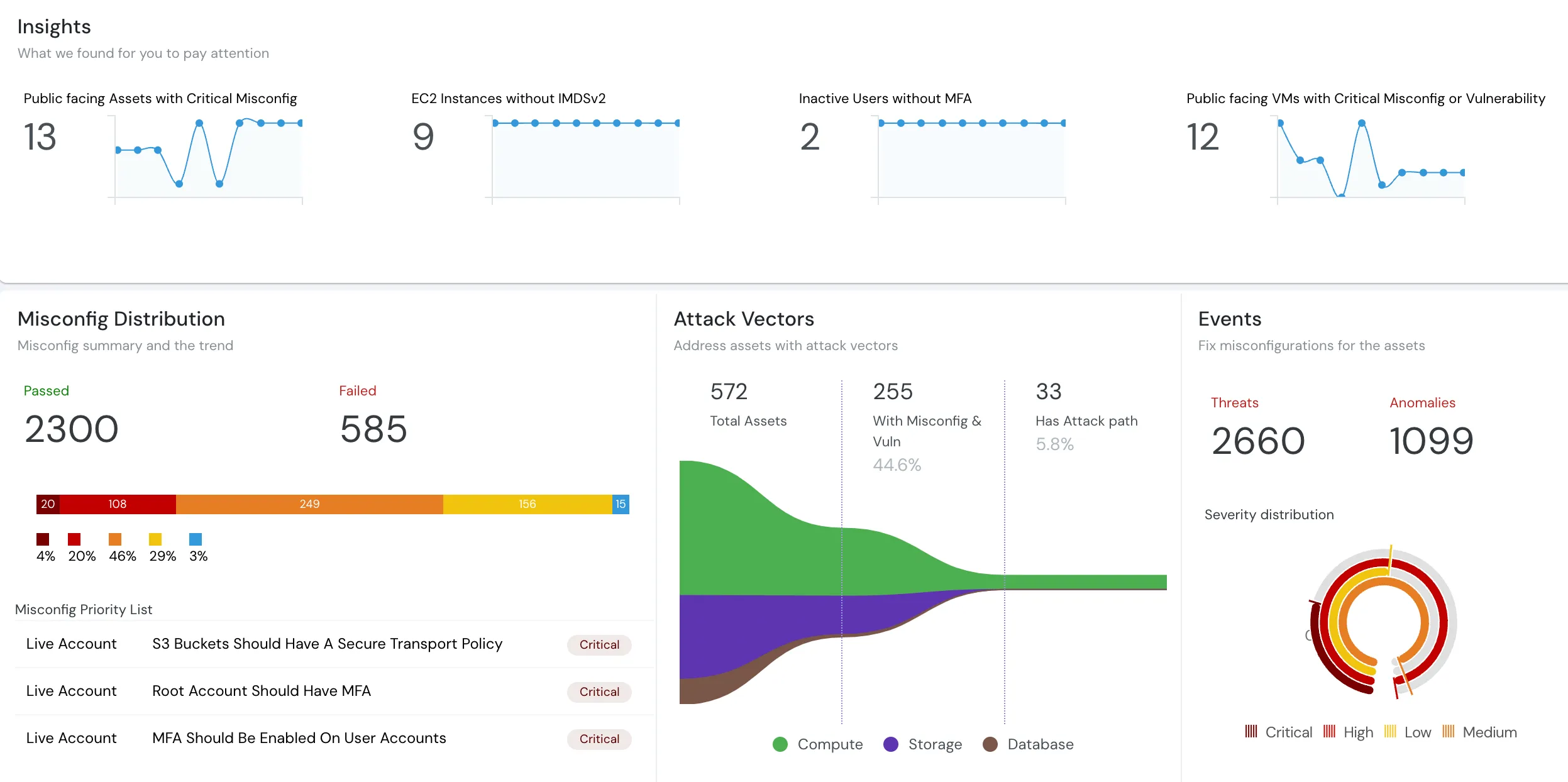Cloudanix
AWS RDS Audit
Your AWS Relational Database Service (RDS) database snapshots should not be publicly accessible. This is to avoid exposing your private data.
RDS Database Snapshots Should Not Be Public
Your AWS Relational Database Service (RDS) database snapshots should not be publicly accessible. This is to avoid exposing your private data.
Cluster Deletion Protection Should Be Enabled
Amazon Aurora databases should be protected from accidental deletion. This is done by having Deletion Protection feature enabled at the database cluster level.
Log Exports Should Be Enabled
Amazon RDS sends general, slow query, audit and error logs from your MySQL, Aurora and MariaDB databases to AWS CloudWatch Logs. Broadcasting these logs to CloudWatch allows you to maintain continuous visibility into database activity, query performance and errors within your RDS database instances.
Serverless Log Exports Should Be Enabled
Aurora Serverless databases should have Log Exports feature enabled in order to publish general logs, slow query logs, audit logs and error logs to AWS CloudWatch.
Instance Deletion Protection Should Be Enabled
Amazon RDS provides a Deletion Protection Flag which should be enabled to prevent accidental prevention of the database.
Automated Backups Should Be Enabled
Automated backups of your RDS database instances should be enabled to ensure point-in-time recovery.
RDS Database Instances Should Not Use Default Ports
Port obfuscation is as an additional layer of defense against non-targeted attacks. In order to leverage this, your Amazon RDS databases instances should not use their default ports (MySQL/Aurora port 3306, SQL Server port 1433, PostgreSQL port 5432)
RDS Instance Should Be of Desired Type
It is recommended that RDS database instances use instance types from a limited set based on the database workload deployed.
RDS Instances Should Have Encryption Enabled
RDS database instances should be encrypted to fulfill compliance requirements for data-at-rest encryption.
RDS Databases Should Have Free Storage Space
If your RDS databases are running low on disk space, they introduce a high risk of hurting your performance and availability.
RDS Instance Count Should Not Exceed Limit
AWS account has Limit Quotas on every service including RDS. The number of RDS database instances provisioned in your AWS account should not have reached the limit quota.
Master Username Should Be Unique
It is not a good practice to use awsuser or admin as master username for your database connection. Instead, use unique alphanumeric username.
RDS Instances Should Not Be Publicly Accessible
RDS database instances provisioned in your AWS account should not be publicly accessible and should instead restrict unauthorized access in order to minimise security risks.
Backup Retention Duration Should Be Present
As an organization you should have a backup policy with atleast minimum 7 days.
RDS Instances Should Not Allow Unrestricted In/Outbound Access
If your RDS instance and it's security group allows access to everyone by setting 0.0.0.0/0, then it invites malicious users to target your database and make your security posture more vulnerable.
Accessibility Should Be Well-defined in Aurora Clusters
All the database instances within your Amazon Aurora clusters should have the same accessibility (either public or private) in order to follow AWS best practices.
Backtrack Feature Should Be Enabled
Backtrack feature should be enabled for your Amazon Aurora with MySQL compatibility database clusters in order to backtrack your clusters to a specific time, without using backups
RDB Instances Should Use Latest Generation of Instance Classes
All RDS databases instances provisioned within your AWS account should be using the latest generation of instance classes in order to get the best performance with lower costs.
Transport Encryption Feature Should Be Enabled
Microsoft SQL Server and PostgreSQL instances provisioned with Amazon RDS should have Transport Encryption feature enabled in order to meet security and compliance requirements
Snapshot Encryption Feature Should Be Enabled
Your Amazon Relational Database Service (RDS) snapshots should be encrypted in order to achieve compliance for data-at-rest encryption within your organization
IAM DB authentication Should Be Enabled
IAM Database Authentication feature should be enabled in order to use AWS Identity and Access Management (IAM) service to manage database access to your Amazon RDS MySQL and PostgreSQL instances
RDS instances Should Not Be Idle
Identify any Amazon RDS database instances that appear to be idle and delete them to help lower the cost of your monthly AWS bill
Event Notification Subscriptions Should Be Enabled
Amazon RDS event notification subscriptions should be enabled for database instance level events.
RDS Instances Should Not Be Overutilized
Identify any Amazon RDS database instances that appear to be overutilized and upgrade (upsize) them to help handle better the database workload and improve the response time
Performance Insights Feature Should Be Enabled
Your AWS RDS MySQL and PostgreSQL database instances should have Performance Insights feature enabled in order to allow you to obtain a better overview of your databases performance
Auto Minor Version Upgrade flag Should Be Enabled
Your RDS database instances should have the Auto Minor Version Upgrade flag enabled in order to receive automatically minor engine upgrades during the specified maintenance window
RDS Instances Should Make Use of Copy Tags
RDS instances should make use of Copy Tags to Snapshots feature in order to allow tags set on database instances to be automatically copied to any automated or manual RDS snapshots that are created from these instances
Use Customer-Managed Keys instead of AWS-managed Keys
Your RDS database instances should be using KMS CMK customer-managed keys rather than AWS managed-keys in order to have more granular control over your data-at-rest encryption/decryption process.
Event Notifications Should Be Enabled
Your AWS RDS resources should have event notifications enabled in order to be notified when an event occurs for a given database instance, database snapshot, database security group or database parameter group
General Purpose SSDs Should Be Used Instead of IOPS SSDs
Your RDS instances should be using General Purpose SSDs instead of Provisioned IOPS SSDs for cost-effective storage that fits a broad range of database workloads
RDS DB Instances Should Not Be Provisioned in VPC Public Subnets
No AWS RDS database instances should be provisioned inside VPC public subnets in order to protect them from direct exposure to the Internet
Multi-AZ Deployment Should Be Used
Your RDS clusters should be using Multi-AZ deployment configurations for high availability and automatic failover support fully managed by AWS.
Renew RDS Reserved Instances Before Expiration (30 days)
Your AWS RDS Reserved Instances (RIs) should be renewed before expiration in order to get the appropriate discount on the hourly charge for these instances
Renew RDS Reserved Instances Before Expiration (7 days)
Your AWS RDS Reserved Instances (RIs) should be renewed before expiration in order to get the appropriate discount on the hourly charge for these instances
RDS Reserved Instances Should Not Have Status - Payment Failed
Identify any failed RDS Reserved Instances (RIs) available within your AWS account. A failed RDS RI is an unsuccessful reservation that received the "payment-failed" status during the purchase process.
RDS Reserved Instances Should Not Have Status - Payment Pending
Identify any pending RDS Reserved Instance (RI) purchases available within your AWS account. A payment-pending RDS RI purchase is a reservation purchase that cannot be fully processed due to issues with the payment method
RDS Reserved Instances Purchases Should Be Reviewed Every 7 Days
All Amazon RDS Reserved Instance (RI) purchases are reviewed every 7 days in order to confirm that no unwanted reservation purchase has been placed recently.
Security Groups Events Subscriptions Should Be Enabled
Amazon RDS event notification subscriptions should be enabled for database security groups events. AWS RDS groups these events into categories that you can subscribe to.
RDS Instances Should Not Be Underutilized
Identify any Amazon RDS database instances that appear to be underutilized and downsize (resize) them to help lower the cost of your monthly AWS bill
RDS RIs Should Have A Corresponding DB Instances
All your AWS RDS Reserved Instances (RI) should have corresponding database instances running within the same account or within any AWS accounts members of an AWS Organization
Amazon Backup Should Be Integrated with Amazon RDS
Amazon Backup should be integrated with Amazon Relational Database Service (RDS) in order to manage RDS database instance snapshots and improve the reliability of your backup strategy.
Security for your Code, Cloud and Data
Cloudanix replaces your 5-6 disjointed security tools within 30 minutes.
Get StartedCLOUDANIX
Insights from Cloudanix
Explore guides, checklists, and blogs that simplify cloud security and help you secure your infrastructure.
Case Studies
Real-world success stories where Cloudanix helped organizations secure their cloud infrastructure. Watch how we made a d...

What is CSPM?
Understand what Cloud Security Posture Management (CSPM) is and how it automates security and compliance across cloud en...
CASB, CSPM, SIEM: Cloud Security Essentials
Understand how CASB, CSPM, and SIEM work together to enhance your cloud security posture and ensure better governance.
What is Cloud Audit?
In-depth assessment of cloud environment for security, compliance, and optimization. Identify vulnerabilities, ensure da...
Top 10 Challenges of CSPM
Cloud environments are getting more complex and dynamic day by day, making it difficult to gain complete visibility into...
Cloudanix docs
Cloudanix offers you a single dashboard to secure your workloads. Learn how to set up Cloudanix for your cloud platform ...
Changelog
A complete history of changes, improvements, and fixes for Cloudanix. Subscribe to get notified about the latest updates...
